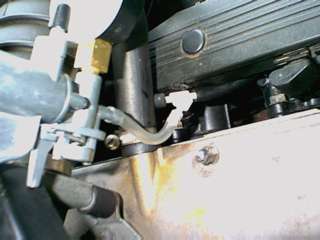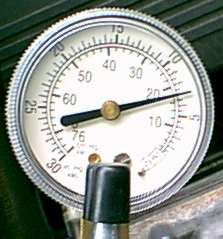|
Engines gets more and more complicated, and diagnostic is less
and less easy. I remember talking to a BMW dealership about a well
known symptom and the answer was: "Oh... the senior mechanic
isn't there, so bring the car we will hook it to the computer...".
Thanks but no thanks.
Some simple tools can be used to diagnose a wide range of problems
with the E34/E32 engines.
What test can I
do and what tools do I need:
• Compression test:
Each cylinder must produce it's share of power. A lack of sealing
in any cylinders will have an effect in the engine power and driveability.
Procedure:
1. Remove all the spark plugs, disconnect the DME main relay and
fuel pump relay (engine with EML, remove the fuel pump relay). 535i,
disconnect the ignition coil wire.
2. Install the compression gauge in the 1st cylinder, crank the
engine a minimum of 4 revolutions and record the first and the highest
readings. If the 1st reading is low and slowly increases to a normal
reading, worn rings or cylinder walls are likely to be a problem.
Results: Minimum: 10-11 bar (142-159 Psi) - Maximum difference
between cyl: 0.5bar (7Psi)
• Cylinder leak testing:
A leakage tester applies regulated compressed air (from a compressor)
to a cylinder trough the spark plug hole. A gauge the percentage
of air pressure lost from the cylinder.
Procedure:
See the website1
for FAQ, website2,
website3
to build your own leakdown tester.
The location of the leak can be pinpointed by carefully listening
for the air escaping. Leaking exhaust valve will be heard exiting
the exhaust, the induction system for the intake valve.
Air bubble coming out of the coolant system could indicate a faulty
headgasket or cracked head.
Worn piston rings, the air will be heard from the crankcase of the
valve cover vent.
When performing the test, a small percentage of leakage by the cylinder
rings is considered normal when the engine is off.

I used a plain vacuum gauge with a small tee tapped into a vacuum
line.
Princess auto has vacuum gauges for cheap.
• Vacuum gauge testing:
That is an interesting test that is often overlooked. The
vacuum gauge is one of the easiest tool to use. Not to mention
the cheap price... What else can you ask for?
Procedure:
1. Take your Bmw for a spin to warm up the engine. Turn the
engine off and use a tee to tap a vacuum line. Connect the
gauge to the tee.
2. Start the engine and take a close look of what the needle
in the vacuum gauge will do.
3. The ideal reading would be a rock steady 17-22 in.Hg (inches
of mercury) @ 1000Rpm.

Possible readings:
- Low steady vacuum reading (15-20in.Hg)
at idle:
This could indicate a problem with an external vacuum leak,
late ignition or valve timing, low compression or stuck throttle.
- Needle fluctuates from 15-20in.Hg
rapidly at idle:
This could indicate a sticky valve or ignition miss. Fluctuation
at higher engine speed might be caused by weak valve springs.
- Gauge needle drifts:
Small intake manifold leak or bad injector o'rings.
- Gauge needle stays steady then drop
regularly to recover and repeat over and over.
Burnt valve(s) or improper valve adjustment. The needle will
drop when the defective valve will operate.
- Gauge needle stays steady then drop
to recover and repeat irregularly.
Sticking valve causes the needle to drop each time it hangs
open. The reading will not drop at regular intervals like
for a leaking valve.
- Gauge needle drops gradually at idle:
Chocked muffler or obstruction in the exhaust system. A restricted
exhaust (like the cat.) will not allow the engine to exhale
properly causing an increase of pressure inside the intake
manifold. The result is a lower manifold vacuum.
|

